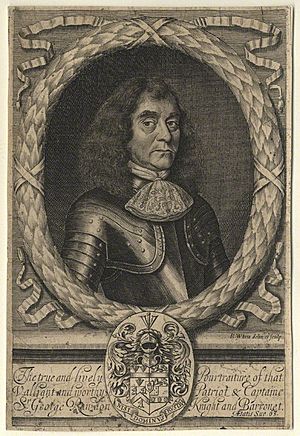Sir George Rawdon, 1st Baronet facts for kids
Sir George Rawdon, 1st Baronet (1604–1684) was an important English army officer and politician. He is famous for founding the town of Moira, County Down in Ireland.
Early Life and Work
George Rawdon was born in November 1604. He was the only son of Francis Rawdon and Dorothy Aldborough. Around 1625, he started working at the royal court. He became the private secretary to Edward Conway, 1st Viscount Conway, who was a very important government official called the Secretary of State. This job meant he helped the King with important papers and decisions.
In 1625, George Rawdon was sent to The Hague in the Netherlands. His job there was to help with money promised by King Charles to his Protestant friends. After Lord Conway died in 1631, Rawdon continued working for his son, Edward Conway, 2nd Viscount Conway. Lord Conway owned a lot of land in County Down, Ireland.
George Rawdon often lived in London, but he also visited Lord Conway's estates in the countryside and in Ireland. When he was in Ireland, he lived in a house called Brookhill near Lisburn. In 1635, he led a group of soldiers there. He also became a member of the Irish parliament in 1639, representing the town of Belfast.
A Time of War
When the Irish Rebellion of 1641 began in October 1641, George Rawdon was in London. He quickly traveled to Ireland and reached Lisburn in November. The town was attacked by Sir Phelim O'Neill and his forces. Rawdon helped defend Lisburn, and they fought off the attackers twice. During the retreat, the Irish rebels burned Brookhill, Lord Conway's house, and Rawdon was hurt.
Rawdon's group of soldiers grew into a larger army unit, and he became a major. In June 1642, he fought under George Monck near Armagh. He was very brave, and his horse was shot from under him during a fight. Rawdon continued to serve in the army in Ulster until 1649, often leading the cavalry, which were soldiers on horseback.
After King Charles I died in 1649, Rawdon left the army. He worked as a tax collector for the Belfast area during the time of the Commonwealth government.
The King Returns
After Oliver Cromwell died in 1658, George Rawdon helped bring King Charles II back to power. This event is known as the Restoration. In 1659, he visited George Monck in Scotland to discuss these plans.
When Charles II became King again, Rawdon was given important jobs. He helped carry out the King's new laws and became a member of the King's special council, called the Privy Council. He also became a member of the Irish parliament again in 1661, representing Carlingford.
In May 1665, George Rawdon was given the special title of Baronet. This meant he was now called Sir George Rawdon, and the title could be passed down in his family. The next year, he received large areas of land as a reward for his service before 1649. He used some of this land to build the town of Moira in County Down. He wanted Moira to be a strong Protestant town.
In 1666, Rawdon helped organize the local army in Ulster. He died in August 1684 and was buried in Lisburn.
Family Life
Sir George Rawdon was married twice. In 1635, he married Ursula Stafford, but she and their only child died the next year.
On September 4, 1654, he married Dorothy Conway, who was the eldest daughter of Viscount Conway. They had seven sons and three daughters. His third son, Arthur, became his eldest surviving son. Arthur Rawdon was the grandfather of John Rawdon, 1st Earl of Moira, who was born in 1720.
Images for kids



